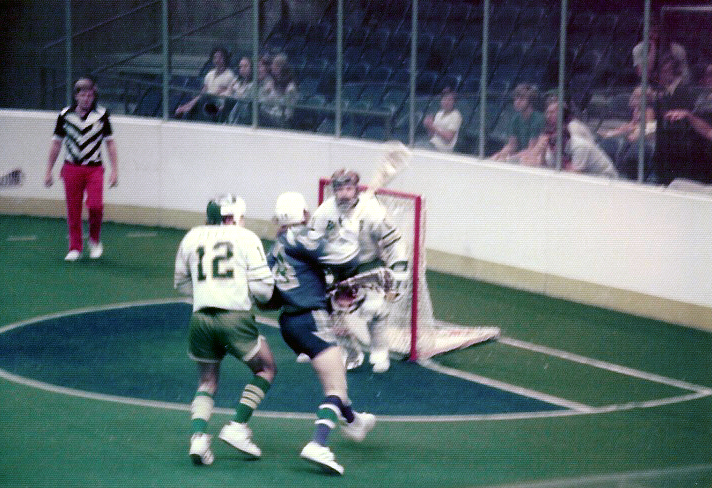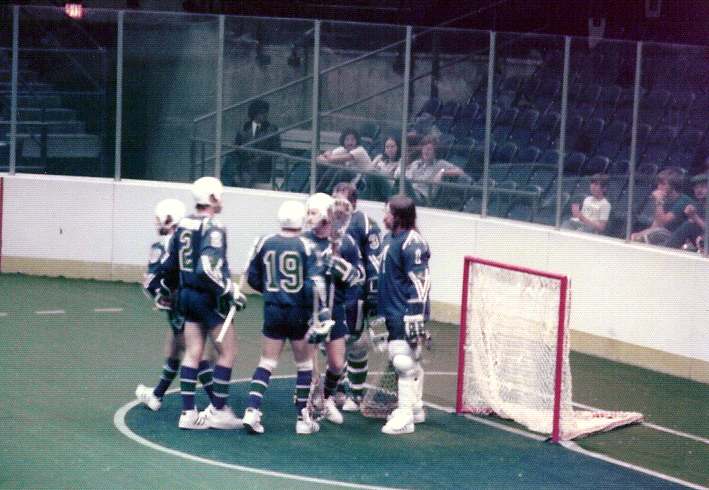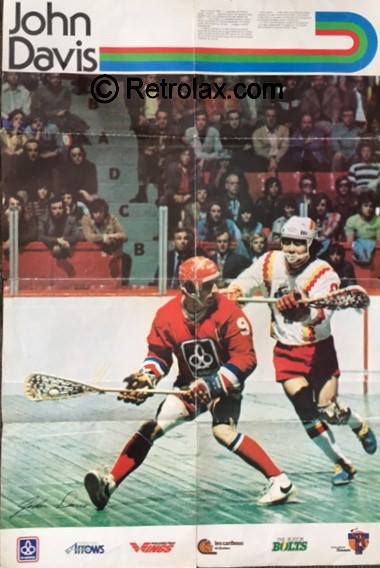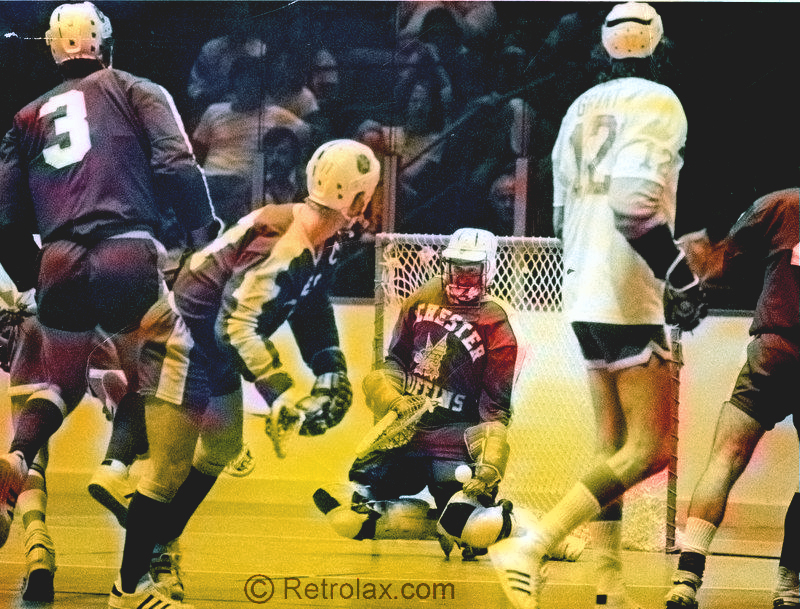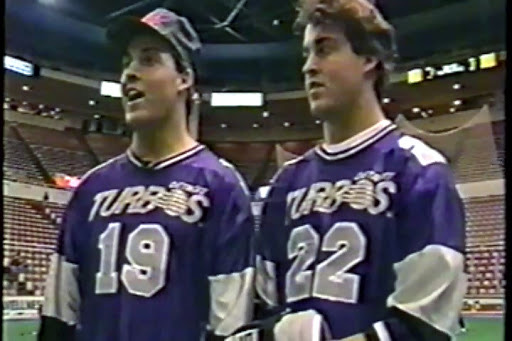(Editor’s notes: the following is an excerpt from Blood & Guts: Violence In Sports (Paddington Press, 1979) which, as the title might suggest, was “an explosive and eye-opening panorama” that was a “hard-hitting and openly condemning…long-overdue exposé” into the unnecessarily bloodthirsty nature of sports. Criticized in the book’s pages were sports like boxing, American football, ice hockey, and even indoor soccer—all features of a “New Rome” where bloodsports were the order of the day.
As a result, one may find the prose that follows somewhat sensationalized, in keeping with the author’s point of view. Factual accuracy was not the order of the day: getting the name of the National Lacrosse League incorrect is just one example. This was not intended to be history.
Which is not to say it is entirely incorrect, either; the NLL was rather shameless in its marketing strategy, making every effort to emphasize the violence of the sport over its considerable skill.
Ultimately, lacrosse fans will enjoy the anecdotes about the NLL, which is why we’ve included it here on RetroLax. Enjoy. SJH)
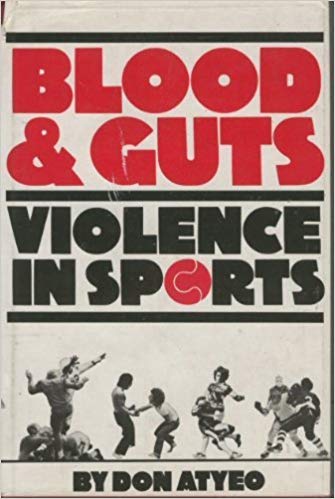
By Don Atyeo
[Roller derby’s] true heir, however, is—or was—box lacrosse, or “boxla” as it was once known. It could be argued that box lacrosse was simply an offshoot from Canada’s moribund professional field lacrosse leagues of the 1930s. But despite some similarities, the two games were so far removed from each other that box lacrosse could legitimately claim to be a sport invented from nothing solely for the purpose of retailing violence. From the beginning, boxla was a fearsome experience, and, not surprisingly, an instant success. First appearing in 1930, by 1931 a professional league had been formed and, a year after that, it had overtaken field lacrosse as the official lacrosse game of Canada.
So great was the Canadians’ enthusiasm for their rough infant that concerted efforts were soon being made to follow ice hockey’s successful migration across the border into the northern United States. Boxla’s future seemed assured, as the New York Herald Tribune was grudgingly forced to concede: “There is no gainsaying the fact that we relish roughness in our sports.” However, the expected support failed to materialize. Hockey had filled all new American sporting markets and boxla was ignored. Finally the league went bankrupt and the game returned to Canada where enthusiasm quickly dwindled. Then, forty years later with ice hockey’s expansion teams brawling their way across the US behind Philadelphia’s Flyers, somebody remembered boxla.
In March 1974 the blue-jawed warriors of the newly incorporated National Box Lacrosse League were unleashed upon an expectant American public. The NBLL was wholly dedicated to the premise that violence sells seats, and for weeks prior to the opening game it had waged a formidable advertising campaign which shamelessly promised sports fans nothing less than the chance of attending a ninety-minute public mugging. The league’s principal ambassador of ill-will was a scarred, toothless cartoon character named Crunch Crosscheck, whose televised messages left as little to the imagination as his motto—“Ya gotta be mean to play lacrosse!” The point was further driven home by a series of radio advertisements which featured “interviews” with various historical bogeymen—Attila the Hun, Genghis Kahn—who all professed envy at the way box lacrosse organized its massacres. (“The meanest game in the woild!” whistled Attila.) Philadelphia fans were easier to sell; they were simply advised to think of box lacrosse as “hockey, where every team is the Philadelphia Flyers.”
“Sure, we promoted violence,” Andy Dolich, the former publicity director of the Maryland Arrows told me later. “We felt to get a mule’s attention you have to punch it in the teeth. We had to get right in the public’s face. We tried to get across to people that if you want a vicarious thrill for two hours, box lacrosse is the game.”
In fact, what took place in the arenas was not too far short of what had been promised. The NBLL’s laws allowed almost anything in the pursuit of player or ball. There was no off-side rule, and a thirty-second time limit on attacks kept the game moving at a frenetic pace. The players themselves were helmeted and heavily padded, and carried hefty sticks which they wielded clublike with abandon. Unlike in hockey their feet were firmly planted on the ground which made for crippling but undeniably spectacular collisions, with players flying ten feet or more through the air.
The majority of the athletes were genuine bruisers, semiprofessionals who knocked off work at the General Motors plant on Friday evening, climbed aboard a DC9, and flew across the border for a game later that same night. When the game finished they flew back home. Like their hockey brethren it was nothing for them to sustain a ten-inch gash, have it stitched at half-time and be back on the boards at the resumption of play. They were also under no illusions about what was required of them. Commented Sy Roseman, a former organizer with the Philadelphia Wings:
When Philly went down to Washington to play the Maryland Arrows is was always a bloodbath—two very aggressive teams who didn’t like each other. This guy, Doug Favell, sat down next to me before the match on one occasion and the way he talked! How he was going to maim people, break people’s legs…I just looked at him. Crazy!
Unlike [ ] Roller [Derby], box lacrosse promised its fans real violence, real bloodshed and real injury, and it delivered them.
Initially this push into the darker reaches of the American psyche was a resounding success. On opening day the Philadelphia Wings, riding blatantly on the Flyers’ coat-tails, drew 12,841 fans to the Spectrum after the Flyers had won the Stanley Cup in the same stadium that same afternoon. A minimum of between seven thousand and eight thousand supporters could be expected at every Wings/Arrows confrontation, with the attendance often rising above the ten thousand mark. In their second season the Arrows were averaging six thousand spectators a match—by any sporting standards a reasonable turnout, and for an unknown game played by unknown people who left the country immediately after the final whistle, remarkable.
“It turned a lot of people off, especially the sports writers,” Sy Roseman told me. “They wouldn’t come to it. They thought they wanted to see sport rather than violence. But it sure turned the fans on. The crowds loved the violence, absolutely loved it!” “There was a section of the public who were turned off,” agreed Andy Dolich. “But there were many more people who thought it was the greatest thing they’d ever seen.”
Sadly for them, box lacrosse survived only two seasons—the summers of ’74 and ’75. It would be nice to think the game failed because it represented some sort of ultimate limit to the fans’ appetite for sporting blood. But that is wishful thinking. The NBLL disintegrated through underfinancing and mismanagement, both Roseman and Dolich agreed. It was the owners in several of the marginal towns, greedy for quick returns and not prepared to nuture their investment, who brought the league crashing. Box lacrosse was not killed at the turnstiles, it simply committed suicide. Where the organization had been adequate, the league flourished.
“Philly was doing just great,” said a wistful Sy Roseman. “We’d sold 2,500 season’s tickets when it stopped and we could have sold 5,000. We had a really great following. The people of Philly loved it. You’d have no trouble in bringing it back in Philadelphia tomorrow.”



